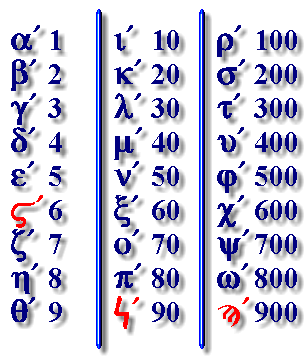 |


|
 |
After they invented their inspired alphabet,
the Greeks used these same twenty-four letters to write numbers as well.
They placed an accent at the top right to indicate that it was no longer
a letter, but a numeral, and that was it. The alphabetical order was kept, but,
as twenty-seven (3 x 9) numerals were needed, three more signs were added:

|
 :
The episimon wau, the ancient vau of the Hebrews and the
Phenicians, the equivalent of the Etolian digamma or of the Latin
"f". :
The episimon wau, the ancient vau of the Hebrews and the
Phenicians, the equivalent of the Etolian digamma or of the Latin
"f".
 ou ou  :
The koppa, The Hebrews' and the Phenicians' coph equivalent to the
Latin "q". :
The koppa, The Hebrews' and the Phenicians' coph equivalent to the
Latin "q".
 :
The sampi (= like a pi), the Hebrews' and the Phenicians' sin. :
The sampi (= like a pi), the Hebrews' and the Phenicians' sin.
|
For example,
oz' equals 77,
rg' equals 103,
ynh' equals 758, etc.
In this manner, people could count up to 999. Above that,
the same code was used, only with the accent at the bottom left.
So
,a equals 1000
,b equals 2000
,p equals 80000, and so forth.

In some ancient inscriptions, other signs can also be found,
nearer to Roman numerals.
The 1 is just a vertical stroke:  . .
The number 5 is symbolized by a
pi, initial of the greek word pente:  . .
The number 10 is symbolized by the letter delta,
initial of the greek word deka:  . .
The number 50 is symbolized by the delta meaning 10
inside the pi meaning pente (5):
 . .
The number 100 is symbolized by the letter eta,
from the greek word hecaton:  . .
The number 500 is symbolized by the eta meaning 100
inside the pi meaning pente:
 . .
The number 1000 is symbolized by the letter chi,
initial of the greek word chilioi:  . .
The number 5000 is symbolized by the chi meaning 1000
inside the pi meaning pente:
 . .
The number 10 000 is symbolized by the letter mu,
initial of the greek word myrioi:  . .
In some inscriptions can be found the numeral  :
ten times ten thousands, i.e. 100 000. :
ten times ten thousands, i.e. 100 000.
|
The latter type of numerals can be seen in Athens' Epigraphic Museum, on stele
6769, which shows Phidias' accounts for the ivory and gold statue of Athena he
made for the Parthenon.
|
|